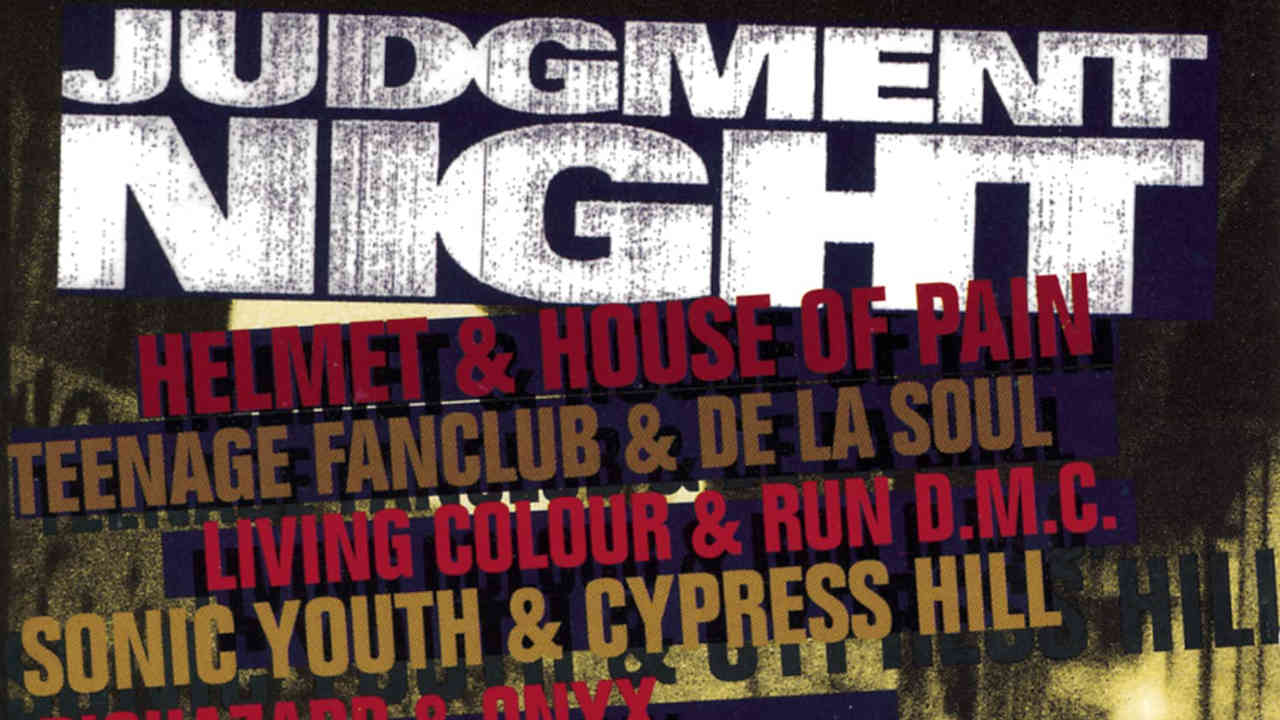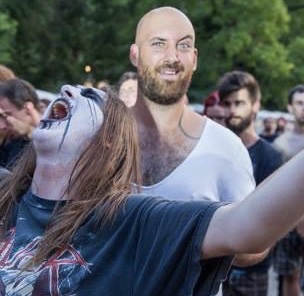The story of how the worlds of rock and hip hop came together has been well told, from Run DMC and Aersomith’s landmark cover of Walk This Way, through Anthrax and Public Enemy’s landmark Bring The Noise, to the crossover stylings of Faith No More, Rage Against The Machine and their contemporaries. But one album always gets overlooked in the history books – the soundtrack to a flop Hollywood movie that helped dismantle the last remaining barriers between the genre, contributing as much as anything to the rap-metal boom that followed.
1993’s Judgment Night is an action crime thriller starring Emilio Estevez, Cuba Gooding Jr. and Dennis Leary. Chances are you’ve either never seen or have completely forgotten it. It currently has a less-than-impressive score of 35% on the movie review aggregator site Rotten Tomatoes, and even House of Pain frontman Everlast, who has a minor role in the movie, has described it as a “piece of shit” and “the most ridiculous movie ever”.
Few would argue with that critique, but the accompanying soundtrack was something else. The Judgment Night OST album was a landmark in the development of rap-rock in particular and 90s music in general – not the first time the two genres had come together, but certainly the most significant to that point. Its genesis pre-dated Rage Against The Machine’s global success, and proved that these two seemingly disparate scenes were way closer than many imagined.
“Judgment Night was a prophetic industry record,” said Run DMC rapper Darryl ‘DMC’ McDaniels, whose band teamed up with groundbreaking, Black rock band Living Colour on the track Me, Myself & My Microphone. “Right after that exploded, Limp Bizkit, all of these groups was doing what was being done on that Judgment Night record. Even when you look at Fall Out Boy or P.O.D., when you listen to those guys, those guys are rap-rockin’.”
The Judgment Night soundtrack was the brainchild of Happy Walters, co-founder of LA label Immortal Records and manager of hip hop acts Cypress Hill, Wu-Tang Clan and House Of Pain. When Cypress Hill’s DJ Muggs told Walters that he wanted his band to do a rap/rock crossover song with Pearl Jam after the two outfits bonded on the 1992 Lollapalooza tour, the mogul realised there was mileage in the idea. Only instead of a one-off, he figured he could do something bigger.
“A lot of alternative artists like hip-hop and a lot artists like alternative,” Walters told Rolling Stone magazine. “It kind of made sense to do something that brought the two genres together.”
When Everlast signed on to appear Judgment Night, Walters spotted his chance. He figured the movie’s would-be gritty take on the gangster genre was the perfect vehicle for his idea. He began to pitch the idea of a soundtrack made up of various rock and rap collaborations to other managers he knew.
“First I had to get hold of all [of them] and get them excited about the project,” Walters told Rolling Stone. “Once that was achieved, the artists had to be stirred.”
It could have gone either way – Rage Against The Machine’s debut album had yet to be released, and the merging of rap and rock was still seen more as a novelty than an industry standard. But Walters recalled a handful of key players being interested from the start.
“Sonic Youth, Helmet, their managers were super supportive,” he told Rolling Stone. “Helmet were super into it. Faith No More was really into it. Those three, I think, were the first ones to come onboard, which were all credible and cool at the time. Which really helped with others.”
Faith No More bassist Billy Gould later recalled being all-in on the idea from the start. “We were pretty popular back then,” said Gould, whose band collaborated with heavyweight Samoan rappers Boo-Yaa T.R.I.B.E on one of the album’s standout tracks, Another Body Murdered. “It was right after [Faith No More’s 1992 album] Angel Dust, so we got offered a lot of compilations, but there wasn’t really a thing with real hip-hop bands collaborating with rock bands. We were like, 'This could actually be something that we do that’s kind of cool.'”
With three ‘name’ bands signed up for the the soundtrack, things began to snowball. Soon, Walters had acquired the services of Pearl Jam, Living Colour, Mudhoney, Biohazard, Teenage Fanclub and Dinosaur Jr. The rappers were equally quick to fall in line: House Of Pain and Cypress Hill were already on Walters’ management roster, while Run DMC had previous experience via their collaboration with Aerosmith. Also into the idea was Ice-T, who described the chance to collaborate with Slayer on Disorder, a raging medley of three songs by UK punk warhorses The Exploited, as working with his “idols”.
“I was familiar with Slayer,” Ice said. “I knew what the fuck was up and I knew they was the baddest motherfuckers at the time. I had no idea what song we were doing until I got to the studio. I showed up in the studio in L.A. and they were already laying the drums. They were mashing us into Exploited, like three songs (War, U.K. ’82 and Disorder).
“We just got in there and screamed,” he continued. “I don’t think we did many takes. Tom [Araya, Slayer vocalist/bassist] and I were both in the booth at the same time. We picked which parts of the songs we would sing and we just blasted it out.”
As exciting as it was creatively, there was also an awareness from some of the acts involved that this was a crossover that would go some way to changing the perception of rap amongst rock fans, and vice versa.
“I’ll never forget that night we were in the studio, there was some racist America shit on, like some talk-news shit,” recalled. Ice. “And there was all these white kids wylin’ out on some racist shit, and they were wearing Slayer shirts. And Kerry [King, Slayer guitarist] just thought it was gonna be great that I was gonna do the song and just fuck their heads up.”
For some of the rock and metal musicians involved, the recording sessions were an eye-opening experience in terms of seeing how their hip hop contemporaries worked.
“It was a new process for us,” Therapy? bassist Michael McKeegan told Hype magazine about their collaboration with rapper Fatal, Come and Die. “[Fatal’s producer] T-Ray had a basic drum loop which he played through the headphones and the three of us just jammed around various parts. It was quite hypnotic, grooving off the loop. Fatal was there getting a feel for it and then he’d go into the rec room and write some lyrics and try them out. I remember everyone getting really excited when Andy [Cairns, Therapy? guitarist] first played that doomy riff. Likewise, we were enjoying how Fatal just kept rapping different lyrics until it sat over the music.”
The finished album perfectly matched Happy Walters’ vision of bridging these two worlds together. Another Body Murdered was a menacing highlight, Slayer and Ice-T’s Exploited medley brought the aggro, while Biohazard and Onyx attempted to out-posture each other on the title track.
Unsurprisingly given the musical climate, there was a heavy alt-rock presence, too. Helmet and House Of Pain joined forces on album opener Just Another Victim, Cypress Hill pulled double-duty with Sonic Youth and Pearl Jam on I Love You Mary Jane and Real Thing respectively, Del The Funky Homosapien pitched in with slacker kingpins Dinosaur Jr. on Missing Link and, bizarrely, Freak Momma found grunge godfathers Mudhoney teaming up with rapper Sir Mix-A-Lot, of Baby Got Back fame.
There were also a couple of blockbusting could-have-beens. Happy Walters approached Metallica to appear on the soundtrack with Cypress Hill, only to be rebuffed by the metal band’s management. “They’re like, 'What? OK, give us a million dollars,’" Happy Walters told Rolling Stone. “It was, ‘Fuck off, kid.’”
Another track that didn’t make the album was a mooted collaboration between two of the era’s fastest-rising bands. A pre-fame Rage Against The Machine and equally-unknown Tool were due to work together on a track titled Can’t Kill The Revolution, only for the song to be scuppered by label politics (it remains unofficially unreleased, though a demo version has inevitably appeared on YouTube).
The Judgment Night movie was released in the US in October 1993 to tepid reviews and quickly vanished. The soundtrack itself had been released a month earlier, to much greater acclaim. The success of Rage Against The Machine’s debut album, released at the end of 1992, several months after Happy Walters had come up with the idea for of the soundtrack, undoubtedly helped push it to No.17 in the US charts, with Just Another Victim and Another Body Murdered getting heavy MTV airplay.
Walters himself tried to repeat the trick again a few years later with the soundtrack to the 1997 movie Spawn, roping in Korn, Metallica, Incubus, Henry Rollins and Tom Morello to work alongside EDM artists such as The Prodigy, The Crystal Method, Moby, Orbital and Goldie. But it didn’t have quite the same musical or cultural impact.
“The movie did bigger, but the soundtrack did less,” Walters admitted. Ultimately, that’s okay; the cross-pollination he inspired and the boundaries his idea destroyed on Judgment Night is more than enough of a legacy.

